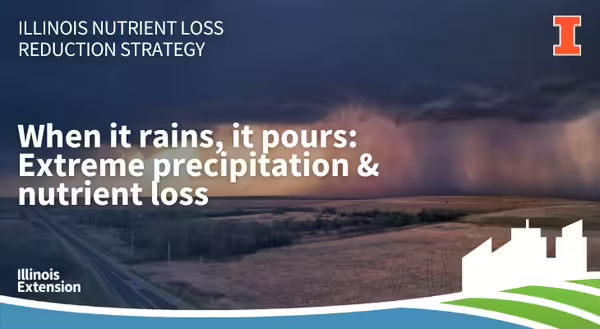
In the last few years, we have experienced several extreme weather events associated with climate change from droughts to intense rain events and flooding. Episode 59 of the Illinois Nutrient Loss Reduction Podcast explores the relationship between extreme precipitation events and nutrient loss in agriculture, highlighting the recent article series, When It Rains, It Pours. In this episode, Dr. Marin Skidmore and Dr. Jonathan Coppess, both with the University of Illinois, dive into the impacts of heavy rainfall and snowmelt on agriculture, shedding light on practical strategies for mitigating nutrient loss.
When it rains, it pours
The age-old proverb, when it rains, it pours, takes a new meaning in the context of agriculture, especially in the face of climate change. As extreme precipitation events become more frequent, the risks for farming increase, posing challenges to nutrient management. A key takeaway that Coppess and Skidmore emphasize is straightforward: to reduce nutrient loss during heavy rain, keep excess nutrients from being available to being lost in the first place.
Extreme rain and nutrient concentrations
Dr. Skidmore reveals findings on extensive research, drawing on over a decade of surface water quality readings and daily weather data. The research findings showed a correlation between extreme rainfall and elevated nutrient concentrations. Particularly, days with over 1 inch of rain exhibit a 50% increase in ammonia and phosphorus, doubling with 2 inches or more. The lingering effects of phosphorus loss persist throughout the season.
Dr. Skidmore’s research, primarily conducted in Wisconsin, delves into the differences between nutrient losses in various landscapes, such as urban, livestock, and cropping areas. Dr. Coppess stresses how important it is to understand the unique ways nutrients move in each region.
Conservation considerations
Dr. Coppess underscores the importance of addressing nutrient loss for farmers and landowners. Beyond potential impacts on economics and production, nutrient losses impact water quality. This affects local drinking water quality and the ability to utilize recreational sites while also creating challenges downstream, leading to issues like the Gulf of Mexico's hypoxic zone.
The conversation explores practical solutions for farmers, considering practices like cover crops, no-till, and nutrient management. The research emphasizes that while farmers can't control the weather, they can implement practices that reduce nutrient losses and make their operation more resilient during extreme precipitation events.
Exploring critical policy factors
Coppess advocates for robust policies that support farmers in adopting conservation practices. While cover crops have many advantages, they can take years to be realized and are expensive for farmers. There are also several other barriers associated with the adoption of cover crops which could include a yield reduction component. He emphasizes the need for public policies and funds to effectively address and support the challenges that are posed by changing weather patterns.
To hear the complete interviews with Coppess and Skidmore, check out podcast episode 59.
Read the entire series:
When It Rains, It Pours: Extreme Precipitation & Nutrient Loss, Part 1
When It Rains, It Pours: Extreme Precipitation & Nutrient Loss, Part 2
When It Rains, It Pours: Extreme Precipitation & Nutrient Loss, Part 3
Learn more about nutrient loss and conservation by checking out the Extension Nutrient Loss Reduction website, live and available at extension.illinois.edu/nlr.
About the authors
Rachel Curry is an Agriculture and Agribusiness Educator focusing on agriculture and watershed education and is a part of the Illinois Extension's Nutrient Loss Reduction Strategy implementation team. Rachel earned a B.A. in Environmental Studies from Knox College and an M.S. in Environmental Science and Soil Science from Iowa State University with an emphasis on soil fertility. Her work focuses on education and outreach regarding the Illinois Nutrient Loss Reduction Strategy and agricultural conservation practices to reduce nutrient loss and improve water quality and soil health throughout Illinois
Nicole Haverback is a Watershed Outreach Associate and is a part of the Illinois Extension's Nutrient Loss Reduction Strategy implementation team. Nicole earned a B.S. in Agriculture and Rural Policy Studies from Iowa State University. She coordinates watershed and planning activities to reduce nutrient losses from priority watersheds, provides expertise on best management practices for nutrient loss, and conducts outreach on agricultural conservation practices outlined in the Illinois Nutrient Loss Reduction Strategy.
About the blog
At Illinois Extension, we’re working to improve water quality at home and downstream. Every month, our Watershed Outreach Associates will bring you stories highlighting agricultural conservation practices, current research projects and results, and from the field farmer interviews. The Nutrient Loss Reduction blog covers conservation practices recommended by the Illinois Nutrient Loss Reduction Strategy, timely updates, farm safety, and new decision tools to help farmers and producers reduce the nutrients leaving their field. Want to get notified when new blog posts are available? Subscribe at go.illinois.edu/SubscribeINLRS.